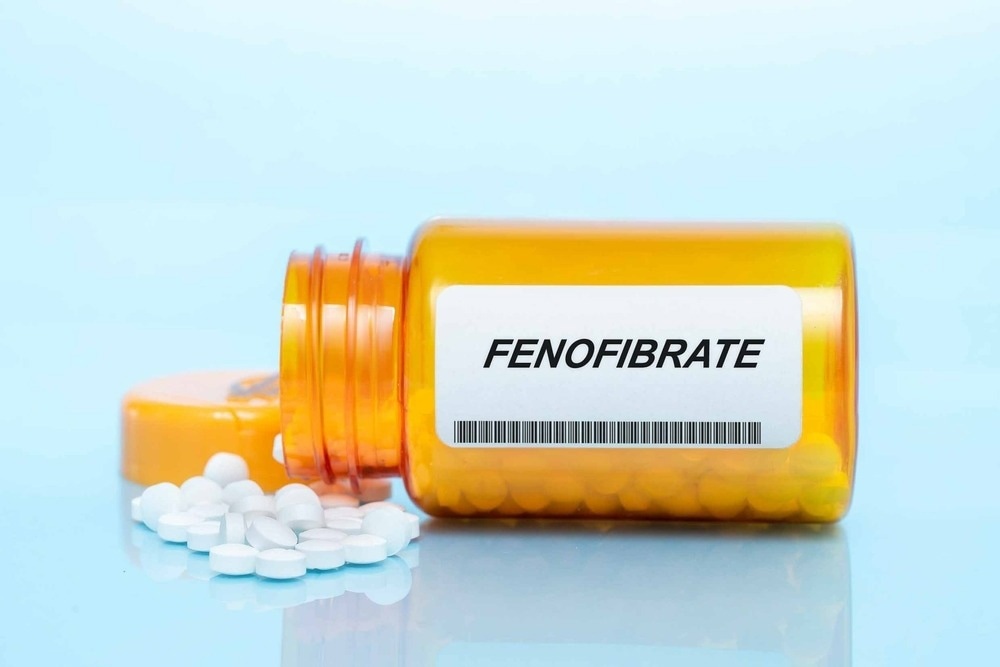In a recent study published in Nature Metabolism, researchers assessed the effect of fenofibrate on acute coronavirus disease 2019 (COVID-19).
 Study: A randomized clinical trial of lipid metabolism modulation with fenofibrate for acute coronavirus disease 2019. Image Credit: luchschenF/Shutterstock
Study: A randomized clinical trial of lipid metabolism modulation with fenofibrate for acute coronavirus disease 2019. Image Credit: luchschenF/Shutterstock
Background
Past studies have shown that the cytotoxicity of severe acute respiratory syndrome coronavirus 2 (SARS-CoV-2) may be caused by the suppression of the peroxisome proliferator-activated receptor-��. In vitro, a compound called fenofibrate suppresses SARS-CoV-2 replication while activating peroxisome proliferator-activated receptor-��. However, it is unknown whether fenofibrate can be an effective therapeutic strategy against COVID-19.
About the study
In the present study, researchers determined whether fenofibrate enhances clinical outcomes in COVID-19 participants.
A prospective, multicenter, randomized, double-blinded study called the FERMIN trial was performed at 25 centers located across six countries, including Colombia, Greece, Lebanon, Mexico, Peru, and the United States. The team assessed the eligibility of participants receiving evaluations in emergency clinics, outpatient clinics, or other emergent/urgent care settings, as well as those hospitalized with COVID-19.
Eligible participants met the following requirements: (1) were at least 18 years old; (2) had a COVID-19 diagnosis based on either (a) clinical presentation having a SARS-CoV-2 positive laboratory test; or (b) had a high clinical probability of having COVID-19 as a Person Under Investigation while also having a compatible pulmonary infiltrates on a chest X-ray or chest computed tomography (CT); (3) less than 14 days had passed since the onset of symptoms; and (4) was able to give informed consent for the study.
Eligible participants were randomly assigned treatments at a ratio of 1:1 to two cohorts: (1) fenofibrate (or fenofibric acid, its active metabolite) administered for 10 days by mouth; or (2) a placebo having a similar visual appearance.
Results
The study cohorts included 701 randomized people. The average age of eligible participants was 49 ± 16 years. The cohort included 330 females, 102 patients having diabetes mellitus, 47 having ischemic heart disease, 186 having hypertension while 302 were inpatients. Almost 351 participants were randomly assigned to receive fenofibrate, while 350 others received a placebo. By real-time polymerase chain reaction (PCR) testing, 62% of subjects tested positive for SARS-CoV-2, whereas the remaining participants tested positive via rapid antigen testing.
The primary intent-to-treat analysis showed that the ranked severity scores between subjects assigned to receive either fenofibrate or placebo were very similar. Adjustment for variables including age, gender, outpatient versus inpatient status, ratio of baseline inspired concentration of oxygen to percentage oxygen saturation (FiO2/SpO2), body-mass index (BMI), ethnicity, race, diabetes status, and county revealed that participants who received fenofibrate had higher average ranked severity scores than the control patients.
In the 30 days after randomization, both arms were similar with respect to the number of days that were spent alive by the patient, out of the intensive care unit (ICU), without requiring invasive or noninvasive mechanical ventilation, extracorporeal membrane oxygenation (ECMO), or the maximum amount of respiratory support. Both arms also displayed similarities in the seven-category World Health Organization (WHO) ordinal scale. The modified ranked severity values were also quite similar between arms.
There were a total of 41 deaths, among which 19 were in the fenofibrate arm and 22 in the placebo arm. There was no discernible difference in all-cause mortality at 30 days between the arms after adjusting for age, gender, outpatient versus inpatient status, baseline FiO2/SpO2, BMI, ethnicity, race, diabetes status, and county. Between the two arms, there were no discernible differences in the Kaplan-Meier failure estimates.
In the 30 days after randomization, both arms experienced an approximately equal number of days spent alive and discharged from the hospital. All arms had similar additional modified ranked severity scores. The team also did not find any effect modification by age, gender, outpatient versus inpatient status, baseline FiO2/SpO2, diabetes status, country, WHO disease severity, formulation, adherence to medication, or compound.
In the fenofibrate arm, there were 46 adverse events compared to 61 in the placebo arm. Except for a marginally higher frequency of gastrointestinal adverse events observed in the fenofibrate arm, there were no discernible variations in the occurrence of adverse events categorized according to the organ system.
Conclusion
Overall, the study findings showed that fenofibrate had no discernible therapeutic advantages among COVID-19 patients. The researchers believe that further research will be crucial to determine whether additional therapies designed to alter cellular metabolic pathways can improve COVID-19 clinical outcomes.